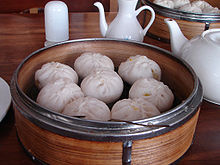- Baozi
-
Baozi 
pumpkin bao Chinese 包子 Transcriptions Mandarin - Hanyu Pinyin bāozi Min - Hokkien POJ pau-á (包仔) Cantonese (Yue) - Jyutping baau1 (包) A bāozi or simply known as bao, bau, humbow, nunu, bausak, pow or pau is a type of steamed, filled bun or bread-like (i.e. made with yeast) item in various Chinese cuisines, as there is much variation as to the fillings and the preparations. In its bun-like aspect it is very similar to the traditional Chinese mantou. It can be filled with meat and/or vegetarian fillings.
Two types are found in most parts of China: Dabao, measuring about 10 cm across, served individually, and usually purchased for take-away. The other type, xiaobao, measure approximately 3 cm wide, and are most commonly eaten in restaurants. Each order consists of a steamer containing about 10 pieces. A small ceramic dish is provided for vinegar or soy sauce, both of which are available in bottles at the table, along with chilli paste.
Contents
History
According to legend, they were invented by the scholar and military strategist Zhuge Liang (3rd century AD).[1]
Types
English name Chinese name Other names Description Cha siu baau, Charsiu bau (simplified Chinese: 叉烧包; traditional Chinese: 叉燒包; pinyin: chāshāobāo) manapua filled with barbecue-flavoured char siu pork; typical of Cantonese cuisine (Guangdong province and Hong Kong) Goubuli baozi (Chinese: 狗不理包子; pinyin: gǒubulǐ bāozi) the most definitive among all varieties; a meat-filled baozi variety from Tianjin, Northern China; its name literally means, "Dogs Will Ignore" Xiaolongbao (simplified Chinese: 小笼包; traditional Chinese: 小籠包; pinyin: xiǎolóngbāo) a small, meat-filled baozi from Shanghai containing a juicy broth. Because it is succulent and prepared only with thin, partially leavened dough, it is sometimes considered different from other bao types, and more closely resembles a jiaozi (dumpling) Shengjian mantou (simplified Chinese: 生煎馒头; traditional Chinese: 生煎饅頭; pinyin: shēngjiān mántóu) a small, meat-filled, fried baozi from Shanghai Tangbaozi (simplified Chinese: 汤包; traditional Chinese: 湯包; pinyin: tāngbao) a large soup-filled baozi from Yangzhou drunk through a straw, in other areas of China, it is small in size with rich soup
Doushabaozi (Chinese: 豆沙包; pinyin: dòushābāo) Hokkien: tāu-se-pau filled with sweet bean paste Lotus seed bun (Chinese: 莲蓉包; pinyin: liánróngbāo) filled with sweetened Lotus seed paste Kaya-baozi filled with Kaya, a popular jam made from coconut, eggs, and sometimes pandan in Malaysia and Singapore Naihuangbaozi (Chinese: 奶黃包; pinyin: nǎihuángbāo) filled with sweet yellow custard filling Zhimabaozi (Chinese: 芝麻包; pinyin: zhīmabāo) steamed, filled with a black sesame paste Beansprout-baozi 芽菜包 steamed, filled with a type of pickle, spices and possibly other vegetables or meat, common in Sichuan, China Ba Pau 生肉包 (shēngròubāo) filled with pork Big Pau 大包 (dàbāo) large buns filled with pork, eggs and other ingredients Culture
In many Chinese cultures, these buns are a popular food, and widely available. While they can be eaten at any meal, bao are often eaten for breakfast. Due to the long history of Chinese immigrants in Malaysia, the Malays have adopted these buns as their own. A particularly Malay form of the baozi (called pau in Malay) is filled with potato curry, chicken curry or beef curry that are similar to the fillings of Malay curry puffs. Some variants have a quail egg in the middle, in addition to the curry. Due to the Muslim beliefs of Malays, these buns are usually halal. You can find Malay stalls selling the buns by the roadside, at pasar malams (night markets), highway rest stops and pasar Ramadans (Ramadan food bazaars).
See also
- Momo, the Tibetan equivalent
- Nikuman (and Chūkaman), the Japanese variants
- Bánh bao, the Vietnamese equivalent
- Mandu (Korean) are filled dumplings in Korean
- manty/mantı (Turkic) Turkish, Persian, and Pakhtan cuisines.
- Manapua, the Hawaiian equivalent
- Mantou Chinese steamed bread without filling.
- Dampfnudel and Maultasche are similar German dishes.
- Siopao are steamed buns in Philippine cuisine.
- Salapao are steamed buns in Sino-Thai cuisine.
- Ravioli
- Pierogi
- Wonton
- Kreplach
- Khinkali
- Jiaozi
- Chinese cardboard bun hoax
Notes
Chinese breads Baozi • Bing • Cha siu baau • Cocktail bun • Cong you bing • Cream bun • Ham and egg bun • Hujiao bing • Kompyang • Laobing • Mandarin roll • Mantou • Naan • Sanchuisanda • Sausage bun • Shaobing • Shengjian mantou • Tohax • Xiaolongbao • Youtazi
American cuisine Latin AmericaAsian cuisine East AsiaChinese: Baozi · Ci fan tuan · Dim sum · Fun guo · Har gow · Hujiao bing · Jau gok · Jiaozi · Lo mai gai · Shengjian mantou · Shumai · Siopao · Suanla chaoshou · Tang bao · Tangyan · Taro dumpling · Wonton · Xiaolongbao · Zhaliang · Zongzi · Other: Akashiyaki · Buuz · Dango · Khuushuur · Mandu · Mandugwa · Manduguk · Mitarashi dango · MomoSouth East AsiaVietnamese: Ba-wan · Bánh bao · Bánh chưng · Bánh lá · Bánh tẻ · Bánh tét · Other: Caozai Guo · Kueh tutu · Kuih kochi · NagasariWest AsiaNorth AsiaEuropean cuisine Bryndzové halušky · Halušky · Kalduny (Kundumy) · Kopytka · Pierogi · Scovardă · Shlishkes · Strapačky · Uszka · VarenykySouthern EuropeCentral EuropeCapuns · Kluski · Knedle · Knödel · Maultasche · Mohnnudel · Pickert · Schupfnudel · Silesian dumplingsWestern EuropeNorthern EuropeOther AustraliaCategories:- Chinese breads
- Dim sum
- Dumplings
- World Cuisine
Wikimedia Foundation. 2010.

